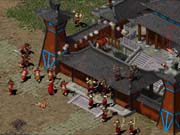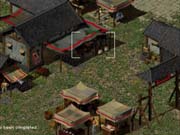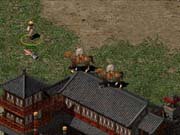In the early '90s, when turn-based strategy games were more popular, a Japanese developer called Koei was well known for creating complex turn-based strategy games based on the epic Chinese work of literature, Romance of the Three Kingdoms, which detailed a key historical period in China, nearly two millennia ago. However, as real-time strategy games became more prominent, the popularity of Koei's Three Kingdoms games waned, and with it, so did interest in games based on the political intrigue and heroic warfare of that particular setting. It's taken a while, but at last a developer has revisited Three Kingdoms' themes and settings to make a real-time strategy game. The result is Eidos and Overmax's Fate of the Dragon, a game that's reminiscent of Microsoft and Ensemble's Age of Empires II but set during Three Kingdoms' historical period.

The Three Kingdoms period in China began around A.D. 220 when the Han Dynasty fell into ruin, giving rise to a short but tumultuous period of warring kingdoms. After much fighting, the dozens of warlords vying for power settled into three kingdoms: Shu, Wei, and Wu, led by the warlords Liu Bei, Cao Cao, and Sun Quan, respectively. Although this time period lasted less than one hundred years, it was so charged with chivalry and epic conflict that it remains the most celebrated era in Chinese history.
Fate of the Dragon lets you play as any of the three warlords. In each of the three campaigns, you control one of the warlord's armies and invariably end up fighting your two rivals, as well as minor warlords and rebels. While the setting itself is rich with history, characters, and intrigue, it only comes across in the scrolling text briefings and the bios of the various heroes you can recruit in the game. There is so much to digest in the briefings that it is easy to become overwhelmed by all the names and events--and thus easy to ignore or miss the historical background. This is a shame because it's the setting that gives this game its distinct appeal. A far better place to inject the history lessons would have been in the game itself, with in-engine cutscenes and voice-overs, but these are rare and even then aren't very well executed. The inconsistent voice acting is also disappointing--at times, it's annoying and too over the top. The missions themselves during the campaigns are very straightforward for the most part. They mostly boil down to attacking a city or killing a warlord. The computer opponent in the single-player game also doesn't appear to be that creative, as it attacks with mostly frontal assaults.
The game supports multiplayer combat for up to eight players, as well as a skirmish mode against the computer, though there is no random map feature. The maps also get monotonous and have little variety because there's only one uniform look to all the maps. The graphics bear a passing resemblance to those of Age of Empires II, with one noticeable difference. The buildings are huge in relation to the units (even bigger than in Age of Empires II), and they convey an even more convincing sense of scale. Otherwise, the 2D graphics are adequate, if a bit familiar, despite the Chinese buildings and units.

Beyond the graphics and the basic game design, Fate of the Dragon makes a few departures from real-time strategy conventions. For one thing, the two gameplay styles of combat and city management are clearly delineated and distinct. The game has two map layers: the city level and the territory level. In the bottom left corner of the screen is the minimap for your city, and in the bottom right corner of the screen is the minimap for the territory level, where your city and opposing warlords' cities lie. You can readily switch back and forth between the two. Inside your city view, you do the same sort of base building as you do in any typical real-time strategy game. After you amass your army, you have to send it out across the territory map to find neutral settlements and enemy cities, which are represented on the territory map as great castles. Battles can take place on the territory map, but invariably, you'll enter your enemy's city level and try to storm his walls and lay waste to his buildings.
Combat itself is incredibly simple and at times dull. There are only three types of troops to build in the game: pikemen, swordsmen, and archers. You can upgrade them and make them stronger, but throughout the game, these are the only troop types you can command. There are more siege engines than troop types, and they include catapults, a ballista, a portable ladder for scaling walls, a kite that can fly troops over walls, and a supply wagon that keeps your troops healthy when they are outside your own city walls. Horses do add a little more complexity to combat. You can create them at stables and mount your troops and generals on them. Those units then gain a speed bonus but are otherwise the same, except that when the mounted unit loses its hit points, its mount dies instead of the mounted unit itself. Horses thus effectively double the unit's hit points. But otherwise, fights in Fate of the Dragon always come down to mobs of troops hacking at each other. There are no formation options in the game to lend any order to the combat.
It isn't the actual tactics of combat that are different in Fate of the Dragon--it's the logistics. Essentially, you need to keep your army constantly supplied. While in your own city, your troops automatically heal their hit points and strength by consuming food and wine. But when you are in the territory map or in an enemy city, your troops will not heal or regain strength until they can rest in a deployed supply wagon, which when deployed turns into a camp. Supply wagons carry only a small amount of food and wine, so for prolonged sieges, you must have laborers and horses carry food and wine back and forth between your hometown and your frontline camps. However, you aren't hamstrung by the supply factor. You can still win through mass attacks--but the clever commander who takes advantage of supply to pull back his wounded and replenish his armies will come out ahead.

The game's most interesting feature is actually its city management. As in most real-time strategy games, you have to harvest various resources to construct buildings and buy units and upgrades. However, some raw materials must also be turned into finished goods. You get timber and iron by sending out workers to gather them, but corn and meat are harvested at farms. Once you build a farm, you send laborers inside and task them as farmers or pig raisers. Farmers then automatically plant fields, while pig raisers create pig farms. Workshops are then used to convert these into wine and food. Thankfully, this process is all automated. Gold is the final resource and is gathered through taxation, not by laborers.
Every minute or so in the game, you automatically gain gold from the people. The number of laborers and soldiers you have actually has no relationship to the city population, which continues to grow at a regular pace throughout the game. The rate of taxation can be adjusted to get you more gold from your people, but doing so has consequences. If you tax the people too much, their morale will drop, which may result in an exodus of your city or even a riot.
Like SimCity, Fate of the Dragon has natural disasters, which include plagues, droughts, locusts, earthquakes, and banditry. These disasters have both direct and indirect consequences, like destroying actual buildings and depleting resources or decreasing city morale. You can give relief to your people in the form of gold and corn, or you can make sacrifices at the temple, which then ameliorate the effects of the disasters. Sacrifices are another of the more distinctive features in Fate of the Dragon: You can build temples and make sacrifices to the gods, thus gaining special bonuses for brief periods. Other types of sacrifices can double production, heal the hit points of all your troops in the game, increase food production, and more. However, to access these more powerful benefits, you need to create a sacrifice officer.
Creating officers highlights another aspect of gameplay: heroes. No Three Kingdoms game would be complete without a strong emphasis on the heroes of the time. Thus, in Fate of the Dragon, you can recruit various famous generals for your cause. In combat, they act as elite troops and gain more hit points, attack power, and special abilities, like the use of healing and defense spells as they kill units and earn experience. And when they're not in combat, they can be appointed to official positions. Much of the late-game abilities available in Fate of the Dragon can be accessed only when you have the four various officers: science officer, public security officer, sacrifice officer, and public affairs officer. For instance, to research the highest upgrades and siege engines, you need to have a science officer. To keep your population stable and in line, you need to have a public security officer. And to make diplomatic treaties with other warlords, you need a public affairs officer. Heroes are important, but you have to keep their loyalty in check by rewarding them. Each hero has a loyalty meter that can only be kept at 100 percent by giving them honorific titles or money.

Fate of the Dragon stands out from other real-time strategy games with its greater emphasis on its strategic layer. The added complexity in the resource gathering is interesting without being overwhelming. The supply needs add an extra consideration to the combat. And the disasters, sacrifices, and heroes are also interesting. However, the game still has its fair share of problems. The tactical gameplay is pretty shallow, and despite the strategic considerations, most battles will devolve into mob fights, as in many other real-time strategy games. Moreover, Fate of the Dragon does a poor job of explaining some of the less obvious aspects of its gameplay. For instance, there is no explanation in the manual, tutorial, or help files as to exactly how much food or wine each unit consumes. While the tutorial does a fairly good job of teaching you the basics, it doesn't go into how to appoint officers, exactly how to replenish troops when they're out of supply, and so forth. You will definitely need to read the manual to get into Fate of the Dragon, and even then, some questions will be left unanswered.
Ultimately, unless the historical Chinese context interests you, you'll find that Fate of the Dragon is just another real-time strategy game with a few original features, but with nothing really outstanding to recommend it. However, if you're interested in the old Romance of the Three Kingdoms games or the time period itself, you'll likely enjoy the game--mostly because it's one of the few of its kind.